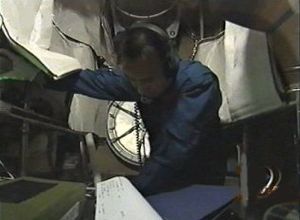
Home - Search - Browse - Alphabetic Index: 0- 1- 2- 3- 4- 5- 6- 7- 8- 9
A- B- C- D- E- F- G- H- I- J- K- L- M- N- O- P- Q- R- S- T- U- V- W- X- Y- Z
Shenzhou 6

Shenzhou 6
Interior view of the descent module later in the flight. One crew member is coming down from the mysterious orbital module, head first.
Launched: 2005-10-12. Returned: 2005-10-16. Number crew: 2 . Duration: 4.81 days.
Details of the activities of the astronauts during the mission were amazingly scant, despite 24/7 coverage on Chinese television. This, and the release of only a few pictures of the interior module, with most of the instruments covered, led to the suspicion that most experiments were military in nature.
Shenzhou 6 was said to have 110 safety and comfort modifications based on the results of the previous Shenzhou 5 manned flight. A better environmental control system maintained the humidity below 80 percent aboard Shenzhou 6. The crew seats had improved impact struts to both better ensure their safety in case of a hard landing and to allow them to see what was going on outside the spacecraft through the portholes during reentry and landing. The spacecraft main computer was a new model. That used on the first five Shenzhou craft had been developed beginning in 1994, and had only 10 megabytes of storage. The new computer was half the size of the previous design, but had 100 times the memory and was10 times faster.
After a nominal launch and entry into orbit, the crew began use of the orbital module for the first time. Remaining in their suits, after testing the atmosphere in the orbital module, the crew cautiously opened first the descent module's forward hatch, then the orbital module's aft hatch. After ensuring good pressure integrity, the crew changed into blue flight jump suits. Presumably experiments in the orbital module required manned monitoring were activated. The crew slept in shifts, with one crew member in a sleeping bag in the orbital module, while the other stayed awake and kept watch in the descent module.
The second day began when Fei woke up after seven hours and eight minutes of sleep. The quality of his rest was reported to the ground using code words to preserve the crew's privacy. Then the two astronauts moved three times between the descent and orbital modules on the 20th orbit, in a test of the spacecraft's automatic motion damping system. The astronauts purposely used violent movements while donning and doffing space suits, moving between the modules, and opening and closing the hatches between the modules. After noon, the crew operated "various other" unnamed equipment in the orbital module. Late in the day, on orbit 30, Shenzhou 6's engines were operated for a few seconds to trim the orbit from a 343 km circular orbit to a slightly elliptical one.
No significant crew activities seem to have been reported on the third day of flight. Press reports stated that Shenzhou 6 carried 50 kilograms of oxygen for the crew, and that the cabin environment remain comfortable, with the temperature from 17 to 25 degrees centigrade, and relative humidity from 30 percent to 70 percent. Shenzhou 6 was said to have cost $110 million (900 million yuan) out of the $2.3 billion (19 billion yuan) that China had spent to date on the Shenzhou program.
On the fourth day of the mission the crew was reported to have conducted a series of otherwise undefined "orbital and ergonomic experiments" which obtained "a large quantity of data on space science". The crew was said to have tested different models of space suits, although it was not clear if this referred only to changing between the suits worn during launch and re-entry and the blue flight coveralls, or if some tests had been conducted with a new-design spacesuit planned for use in extra-vehicular activity in future flights. Chinese President Hu Jintao talked with the two astronauts during the day.
On the final day of flight, the crew prepared the spacecraft for landing and donned their spacesuits for the return. Re-entry went according to plan as follows:
- 19:42 - The tracking ship Yuanwang 3, off the coast of Africa, acquired Shenzhou 6
- 19:43 - Yuanwang 3 received verification that the spacecraft had automatically oriented itself for retrofire
- 19:44 - Orbital module separation. The module remained in orbit to serve as an unmanned military satellite.
- 19:45 - Retrofire - the main engines on the Shenzhou's service module ignited.
- 19:48 - Main engine shutdown. Shenzhou had been braked so that its path would enter the atmosphere.
- 20:07 - The service module separated from the re-entry capsule. It was left to burn up in the atmosphere.
- 20:20 - The re-entry capsule completed aerodynamic braking and was at subsonic speed. The main parachute deployed.
- 20:23 - The re-entry capsule's heat shield jettisoned. This exposed the soft landing motors at the base of the capsule and the altimeter that would ignite them just milliseconds before impact.
- 20:32:50 - Soft landing within sight of the recovery forces (04:32:50 local time)
On 21 October the orbital module fired its engines twice to move into a 355 km altitude orbit. It was expected to continue unmanned operations there for another six months.
Post-flight announcements also indicated that the Shenzhou program would continue at a slow pace. Shenzhou 7 would feature China's first spacewalk, but would not take place until 2007. Shenzhou 8 would be the first all-up spacecraft. It would rendezvous and dock with Shenzhou 9 in 2009, but both were to be flown unmanned. Shenzhou 10 would return Chinese astronauts to space and demonstrate the first manned docking, but could fly as late as 2012. It was reported that government clearance to begin construction work on the country's next-generation launch vehicle family was delayed. This was possibly the reason for an evident slow-down in the manned space project.
What was the real work of Shenzhou 6?
Shenzhou 1 and 2 flew with dummy or partial electronic intelligence packages. On those flights three extendible booms were part of an experimental magnetic attitude sensing and control system. Shenzhou 3 and 4 flew with a complete electronic intelligence payload mounted on the nose, which allowed coverage of the entire earth below as the orbital module passed overhead.
The military payload flown aboard Shenzhou 5 was an imaging reconnaissance package. This consisted of two cameras, the larger with an aperture of 500 - 600 mm. One was mounted in the equipment package at the nose of the spacecraft, the other below it at what had been earlier thought to be the porthole above the orbital module's main hatch. The use of two differing cameras suggested a combination mapping/close-look system. Zhang Houying of the Chinese Academy of Sciences gave the ground resolution of the close-look CCD camera as 1.6 m. Shenzhou 6 seems to have carried only the single large camera mounted at the "porthole" position. The box-like instrument package on the forward end of the orbital module did not seem to have the secondary camera mounted on Shenzhou 5. The few interior shots of the orbital module showed it to be rather sparsely furnished -- perhaps payload had to be offloaded for the second cosmonaut, or the military equipment was designed only for automated operation from the ground?
In any case it may be inferred that the main mission of China's second manned spaceflight was a continuation of the military imaging reconnaissance conducted by Shenzhou 5. The logical experiment would be to test if the presence of a man in the loop improved the quality of reconnaissance imaging. The crew member could identify targets of interest, and make quick adjustments in the event of changes in weather conditions over the target. Attempts could also be made at locating and photographing moving or poorly identified targets. The Soviet Union conducted such experiments with its Almaz military space station in the 1970's - and concluded that the astronaut did not contribute enough value to justify manned military space reconnaissance. The Almaz project was canceled.
More at: Shenzhou 6.
Family: Manned spaceflight. People: Fei Junlong, Nie Haisheng. Country: China. Spacecraft: Shenzhou. Launch Sites: Jiuquan.
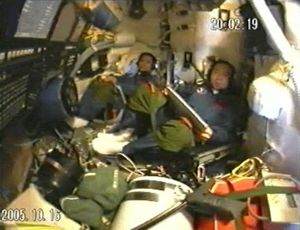 | Shenzhou 6 Interior view of the descent module later in the flight. The crew were now both wearing coveralls. |
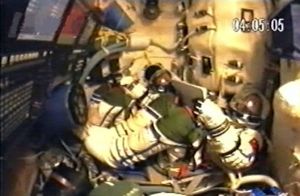 | Shenzhou 6 Interior view of the descent module early in the flight. The crew still both wore spacesuits for safety at this point in the mission. |
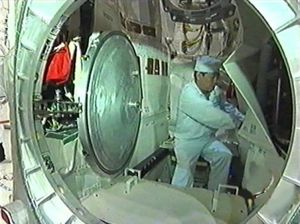 | Shenzhou 6 Interior view of the Shenzhou 6 orbital module during assembly. Again the panels are covered with white sheets to hide their contents. |
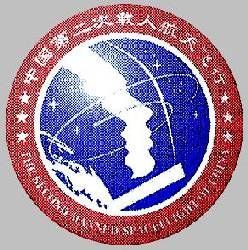 | Shenzhou 6 Credit: www.spacefacts.de |
2005 October 12 - . 01:00 GMT - . Launch Site: Jiuquan. Launch Complex: Jiuquan SLS. LV Family: CZ. Launch Vehicle: Chang Zheng 2F.
- Shenzhou 6 - .
Crew: Fei Junlong,
Nie Haisheng.
Backup Crew: Jing Haipeng,
Liu Buoming.
Mass: 8,040 kg (17,720 lb). Nation: China.
Related Persons: Wu Jie,
Zhai Zhigang.
Agency: SISE.
Class: Manned.
Type: Manned spacecraft. Flight: Shenzhou 6.
Spacecraft: Shenzhou.
Duration: 4.81 days. Decay Date: 2005-10-16 . USAF Sat Cat: 28879 . COSPAR: 2005-040A. Apogee: 338 km (210 mi). Perigee: 331 km (205 mi). Inclination: 42.40 deg. Period: 91.20 min.
Moved up from October 13. Second Chinese manned space mission. The two-astronaut crew spent 5 days in space, and worked in the Shenzhou orbital module for the first time. Aside from biomedical experiments, the nature of their work was not divulged, and few images of the interior of the orbital module (with its probable military experiments) were released.
2005 October 16 - .
- Shenzhou 6 lands - . Nation: China. Related Persons: Fei Junlong, Nie Haisheng. Flight: Shenzhou 6. Spacecraft: Shenzhou. Shenzhou 6 soft landed within sight of the recovery forces at 04:32:50 local time..
2005 October 16 - . 20:33 GMT - .
- Landing of Shenzhou 6 - . Return Crew: Wu Jie, Zhai Zhigang. Nation: China. Related Persons: Wu Jie, Zhai Zhigang. Program: ISS. Flight: Shenzhou 6.
Back to top of page
Home - Search - Browse - Alphabetic Index: 0- 1- 2- 3- 4- 5- 6- 7- 8- 9
A- B- C- D- E- F- G- H- I- J- K- L- M- N- O- P- Q- R- S- T- U- V- W- X- Y- Z
© 1997-2019 Mark Wade - Contact
© / Conditions for Use
